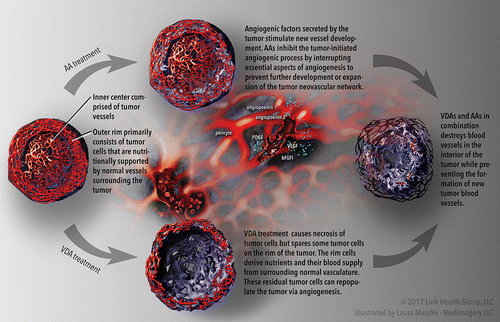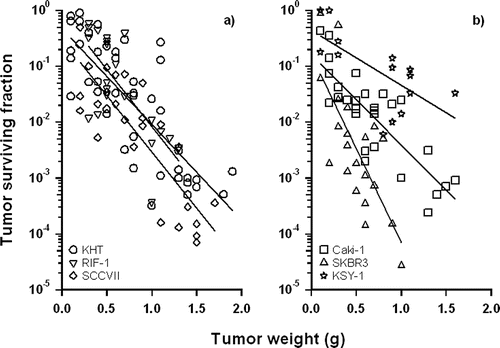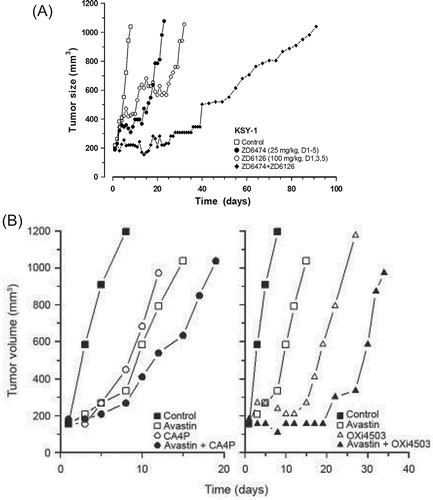Figures & data
Figure 1. Solid tumor undergoing treatment with combined vascular targeted therapies (VTT). The top portion of the figure illustrates anti-angiogenic agent (AA)-induced inhibition of tumor progression. The lower portion of the figure illustrates vascular disrupting agent (VDA)-induced necrosis of the central tumor cells (with a peripheral rim of viable tumor cells spared). The right-hand side of the figure illustrates the complementary effects of VDAs and AAs in combination (combined VTT): the destruction of blood vessels in the interior of the tumor and the prevention of new tumor vasculature formation, which together have negative effects on the tumor's growth and survival. ©2017 Link Health Group, LLC; Illustrated by Laura Maaske, Medimagery LLC.

Table 1. Select anti-angiogenic agents that are FDA-approved for cancer treatment.
Table 2. Vascular targeted therapies in active clinical development.
Figure 2. Tumor surviving fractions in rodent (a) and human (b) tumor models treated at various sizes with a single dose of ZD6126 150 mg/kg. Survival assays were performed 24 hours after treatment. Data points represent individual animals, and results for each tumor model were fit by linear regression. Data from Siemann and Rojiani, 2005 (Citation12); with permission.

Figure 3. (A). The response of KSY-1 xenografts in mice treated with ZD6474 and ZD6126 either alone or in combination. ZD6474 was administered on a daily basis for 5 days starting when the tumors reached 200 mm3. ZD6126 was given on Days (D) 1, 3, and 5. In the combination group, on days when both agents were administered, ZD6126 preceded ZD6474 by 1 hour. The results show the growth of the median tumors of groups of 8 mice. In the anti-angiogenic agent plus vascular disrupting agent combination, 3 of 8 tumors were controlled. Data from Siemann and Shi, 2004 (Citation115); with permission. (B). Response of Caki-1 tumors to Avastin® (2 mg/kg, twice weekly for 2 weeks), CA4P, or Oxi4503 (100 mg/kg or 25 mg/kg, respectively, thrice weekly for 2 weeks), or the combination of anti-angiogenic agent and vascular disrupting agent. Data shown represent median tumor responses of groups of 8 to 10 mice. Data from Siemann and Shi, 2008 (Citation160); with permission.

